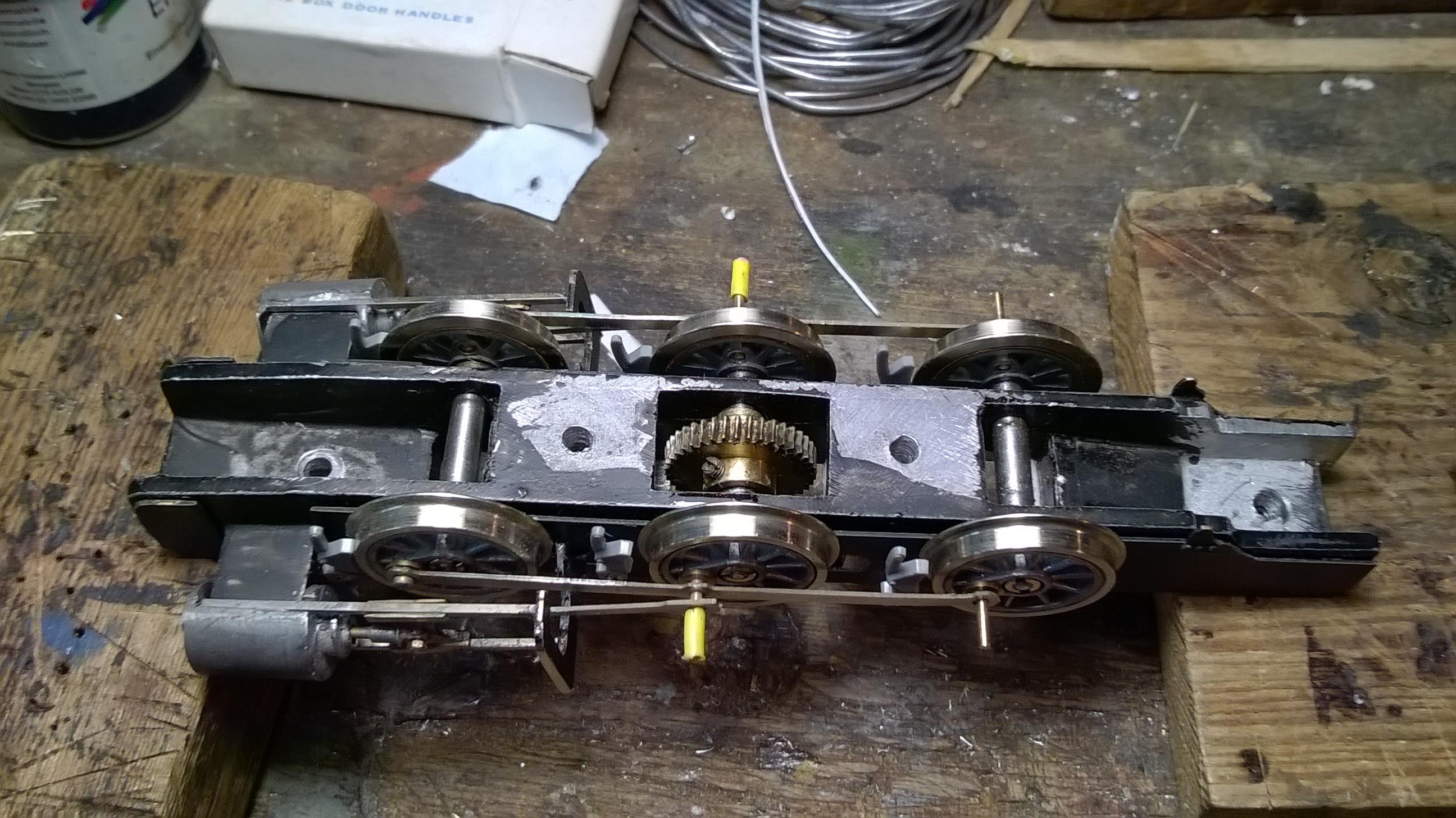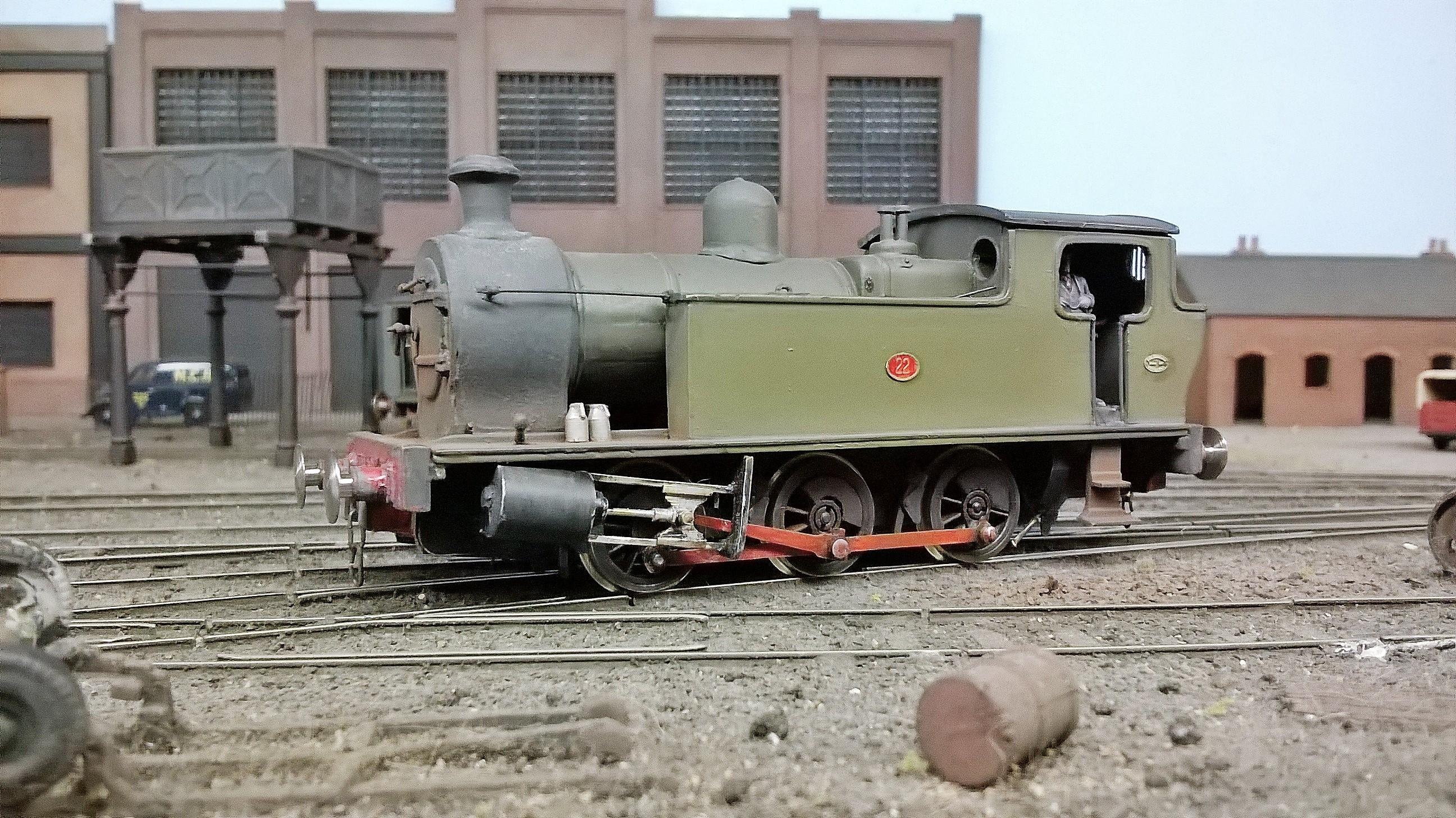› Members Forum › Layout Wiring and Control › DC › Supercaps for DC Stay-Alive
- This topic has 14 replies, 4 voices, and was last updated 1 year, 10 months ago by
Paul Willis.
-
AuthorPosts
-
-
October 17, 2021 at 10:43 am #239360
John Cutler
ParticipantI have no electronics expertise whatsoever. From reading on forums it seemed the only ways to cure dead spots over dirty or gapped rails were to either fit a large flywheel or go DCC and fit a decoder. Then I encountered a thread on RMWeb (by AndyID) suggesting that supercapacitors could be used with ordinary DC.
Capacitors can store energy and release it when the normal power fails e.g. when a loco encounters dirty track. Ordinary traditional capacitors are asymmetric i.e. their polarity is fixed, so cannot (easily) be used like this if you want a loco to be capable of reversing. Some new supercapacitors are symmetric, however.
The Kyocera SCCR12E105PRB is a 3v 1F supercapacitor measuring 8mm diameter x 12mm length. You need 4 per loco, assuming you use a normal 12v motor. I paid £1.49 per supercap from Mouser Electronics:
https://www.mouser.co.uk/ProductDetail/AVX/SCCR12E105PRB?qs=qSfuJ%252Bfl%2Fd7z2XKk8jG7Cg==
I wired the 4 supercaps as per the RMWeb diagram:
These were soldered to a piece of Veroboard gapped to match the diagram and with a bit of fiddling were fitted inside the tender of a Hornby Drummond Goods 700. The tender weights had to be discarded to make room so the tender chassis was stuffed full of lead wherever possible to bring the total weight back to just above the original.
The resulting performance enhancement amazed me. No more stuttering over lousy pointwork. No more prodding the loco to get it back to life. More than this, though. No more prodding to get it started; it starts every time! I had not predicted that (and am not sure why this should be so). Starting seems smoother as well. This means this is a perfect low-cost upgrade for exhibition DC locomotives; no more embarrassing motive power failures in front of the punters (with my awful track there would still be derailments however!).
The downside is that one has to learn to drive differently. The loco does not stop when the power is switched off but slows down. This might make precision shunting rather difficult but practice should make perfect! Exhibitors might have to rethink platform lengths; novice drivers are going to overshoot short platforms.
So give this a try in a tender locomotive. Why spend a fortune on DCC when you can get a similar performance for only £6 per loco? My prediction is that DCC prices will continue to fall so using supercaps as a cheap interim measure you can get maximum effect for your bucks by upgrading your whole fleet to DCC later with the latest specifications. Personally, I am waiting for one of the major producers to provide lithium batteries and Radio Control.
Unfortunately the size of a single supercap means fitting 4 of these in a small tank loco is an issue. I would love to get some suitably smaller supercaps with the same characteristics to go in my Hornby Terrier (with its awful and unreliable pickups). Has anyone got any suggestions, please?
-
October 17, 2021 at 1:25 pm #239399
John Cutler
ParticipantHealth Warning!
If you try these supercaps, you should be aware that if you reverse their polarity whist they are discharging (during stay-alive), you will reduce their lives.
In other words, try not to apply Reverse on your controller as the loco heads toward a cliff-edge! Start thinking seriously about fixing down your buffer stops, just like the prototype! -
October 22, 2021 at 11:41 am #239570
 Stuart FirthParticipant
Stuart FirthParticipantFascinating – I too have been reading about this on RMWeb but I’m pleased to see you have produced a working example. How long is the run-on when you switch off the power?
-
October 24, 2021 at 4:28 pm #239590
John Cutler
ParticipantThe run-on after switching off the power at full speed is between 51 and 54 cms, more usually 51 cms. This is for the Hornby 700 Goods without any load (other than the tender). I guess other locos will differ depending upon motor and weight.
-
-
October 25, 2021 at 8:38 am #239598
 Stuart FirthParticipant
Stuart FirthParticipantI think I must try this – my old dinosaur Kerr Stuart Victory built from a Centre Models kit with a cast white metal chassis block is not as reliable as my compensated loco’s – perhaps a perfect test bed…
-
July 31, 2022 at 4:40 pm #242399
 Nick RidgwayParticipant
Nick RidgwayParticipantCast whitemetal chassis? How worrying! Yuk! If relying on this and the wheels insulated one side then the first upgrade would be backscratcher pickups onto the chassis block.
if that didn’t give all the required improvements then supercapacitors would be the next step
Then, I’m funny that way…
-
August 2, 2022 at 4:28 pm #242453
 Stuart FirthParticipant
Stuart FirthParticipantHa ha that’s what I thought but it ran very sweetly, except that I couldn’t compensate it of course.
Pickups all round mind you but still not as reliable as a compensated one.


-
August 20, 2022 at 9:16 pm #242617
John Cutler
ParticipantHave you thought about introducing some vertical slop for the rear drivers? (Make sure it is vertical-only slop!). Then fix a spring above and across the centre of the axle. The spring probably needs to be soft to avoid axle-wear and to allow vertical movement but strong enough to be a fulcrum; experiment! From the photo this looks as if it should be easy to fit. This means you will have a minimum of 4 wheels in contact with the rail as opposed to 3 now. This is the system Bachmann successfully use on many of their locos (57xx/8750 panniers, Collett Goods, N mogul, LMS Jinty, BR 4MT tank) to improve traction and pick-up; they spring the centre drivers. Good Luck!
-
-
August 21, 2022 at 4:28 pm #242643
 Stuart FirthParticipant
Stuart FirthParticipantHi John – interesting thought, but this model is pretty heavy, and unless the rear axle was strongly sprung, I think it would teeter around the middle axle, and maybe pop a wheelie when it started up. Plus it has the one piece rods as supplied in the kit, so they would need to be altered. Once you get that far you are perilously close to throwing it away and making a new chassis!
I am still tempted by the capacitors though. I suppose the difference to DCC is that the loco is not under your control – the run on will happen regardless of what you want it to do, which might be an interesting replication of the momentum involved in driving a real engine.
-
September 28, 2022 at 10:53 pm #243057
Paul Willis
Participant“I am still tempted by the capacitors though. I suppose the difference to DCC is that the loco is not under your control – the run on will happen regardless of what you want it to do, which might be an interesting replication of the momentum involved in driving a real engine.”
Not quite right. There is a difference between DC and DCC when rail contact is lost and the capacitor comes into play.
In DCC, the locomotive will still not be under control i.e. it won’t respond to any new commands, including any to stop! What it will do is continue to proceed using the settings that were last sent to the DCC chip before power was lost. Then those will be overridden when contact with the control signal is resumed.
In DC, there really will be no control – the locomotive will continue to proceed using whatever “raw” power the capacitors are sending to the motor. There is no way of moderating or controlling that reaction.
I’d be interested to see some real life experiments with DC control and capacitors. I suspect that for the more powerful ones, it will be quite spectacular!
-
September 29, 2022 at 8:54 am #243058
 Stuart FirthParticipant
Stuart FirthParticipantAbsolutely – anything that provided too much run-on would be very interesting to drive. It could simplify matters too – a tender loco. would probably only need pickups on the tender and still run very smoothly.
-
September 29, 2022 at 11:30 am #243061
 Nick RidgwayParticipant
Nick RidgwayParticipantThe only reservation about <…supercaps…> is their potential incompatibility with feedback controllers. These controllers depend on continually reviewing the motor speed, by measuring its back-EMF, and adjusting the width of the next few pulses in order to maintain constant motor speed. With a <…super cap…> in parallel with the motor, the perceived back-EMF will be the same as the voltage applied to the motor, more-or-less, which will affect the controller’s behaviour. It will go weird.
Would someone like to experiment and report back, please?
-
September 29, 2022 at 9:47 pm #243066
John Cutler
ParticipantMy next loco scheduled to be fitted with supercaps is a heavy Bachmann N. The last time I ran this up against the buffers, the rails underneath shot out from the flexi-track with considerable velocity! With supercaps fitted the N will need to be driven very gently in the yard!
Let me say that I have no experience of DCC. One clear disadvantage of supercaps with DC control is that precise shunting, especially to auto-couple or -uncouple, is difficult and takes practice. I suspect that there is more control with DCC except when there is no track signal e.g. on an electrically dead section of track.
I have an aversion to investing large amounts of money in DCC; I think the future lies in radio control. My current strategy is to install supercaps in tender locos at low cost and to try R/C in small tank locos so shunting will be less of an issue. Just think about the wiring. The next layout may have lots of dead frogs!
-
September 30, 2022 at 8:41 am #243068
 Stuart FirthParticipant
Stuart FirthParticipantI couldn’t agree more about DCC, though I’m sure it helps if you have dead frogs and no compensation. At an exhibition on Saturday I was driving a lovely DCC diesel shunter (not mine), that had a great deal of momentum programmed into it. It was challenging to drive, but good fun. Of course, with DCC you always have the ‘STOP’ button to get you out of trouble!
-
September 30, 2022 at 11:09 pm #243079
Paul Willis
Participant“I have an aversion to investing large amounts of money in DCC; I think the future lies in radio control. My current strategy is to install supercaps in tender locos at low cost and to try R/C in small tank locos so shunting will be less of an issue. Just think about the wiring. The next layout may have lots of dead frogs!”
Not wanting to repost a load of content, can I just point you in the direction of this discussion on Radio Control:
Scalefour Society Radio Control Starter Kits
We’ve worked to make a package that is (a) ready to fit and (b) easy to use. With an article about the Starter Kits in the Scalefour News before Scaleforum, we were still surprised that we sold out of all stock by 1pm on the Saturday, last weekend at Scaleforum. The demonstrators who have put the kit together were busy all weekend…
The linked thread should answer most of a starter’s questions about radio control, and how to use it.
We’re currently rebuilding our RC stocks in the Stores ready for people to want to fit it to a second locomotive!
-
-
AuthorPosts
- Only logged in EMGS members can reply to this topic


